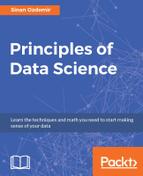Data communication is not an easy task. It is one thing to understand the mathematics of how data science works, but it is a completely different thing to try to convince a room of data scientists and non-data scientists alike of your results and their value to them. In this chapter, we went over basic chart making as well as how to identify faulty causation and the ability to hone our oral presentation skills.
Our next few chapters will really begin to hit at one of the biggest talking points of data science. In the last nine chapters, we spoke about everything between how to obtain data, clean data, and visualize data in order to gain a better understanding of the environment that the data represents.
We then turned to looking at the basic and advanced probability/statistics laws in order to use quantifiable theorems and tests on our data to get actionable results and answers.
In subsequent chapters, we will take a look into machine learning and the nature in which machine learning performs well and doesn't perform well. As we take a journey into this material, I urge you, the reader, to keep an open mind and truly understand not just how machine learning works, but also why we need to use it.
